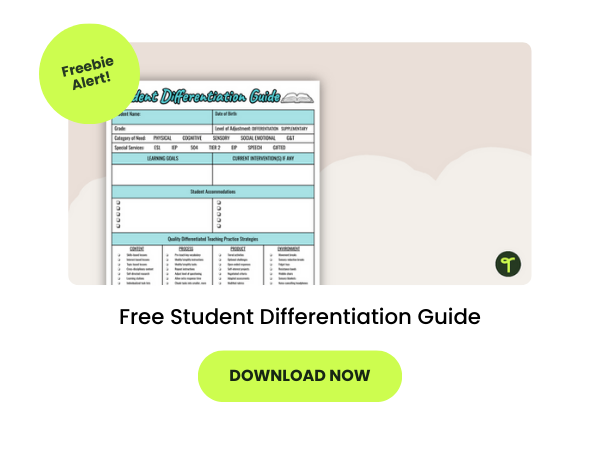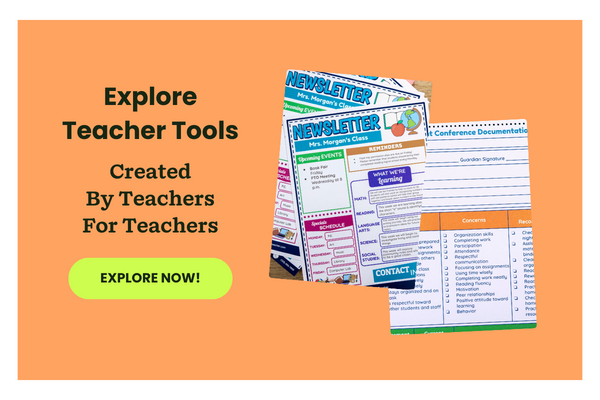When you’re teaching a classroom full of students with a diverse range of learning needs, differentiation strategies are your best friend. Then again, when you’ve got a classroom full of students with a diverse range of learning needs, differentiation can also be a huge challenge — even for experienced veteran teachers.
After all, we’re all struggling with a lack of time, and many teachers face a lack of resources. So how do you find the time — and the resources — to differentiate instruction to meet every child where they’re at? What differentiated teaching strategies will help you in your classroom?
The teachers on the Teach Starter team take differentiation seriously — it’s why so many of the resources on our site have differentiated components— and we’ve done a comprehensive review of both the history of differentiated learning and the ways different schools all around the world make differentiation work for their students.
Read on for a look at what differentiation means, how it came about and some of our teacher team’s best tips to help you build your differentiation skills in the classroom!
What Is Differentiation in Education?
Differentiated instruction is the term we use to describe the practice of adapting instruction, content and assessment to meet the diverse learning needs of all the students within a single classroom.
Differentiated instruction has been part of the education system for centuries. Remember one-room schoolhouses? Where one teacher taught a room full of students of various ages and developmental levels? Differentiated instruction strategies were what kept those teachers going and their students learning.
Of course, as we changed to centralized schools where students around the same age were separated out to learn within grade levels, the individualized instruction common in those one-room schoolhouses slowly but surely disappeared. Teachers were expected to teach a one-size-fits-all curriculum, and differentiation largely went out the window.
The swing back the other way has happened over decades, with some key figures in the education community helping to bring us to where we are today. The advent of the Individuals with Disabilities Education Act (IDEA) — and with it federal protections for students with learning disabilities — has made differentiated education not just something teachers want to do because they care about their students’ and student achievement but something they’re required to do under many kids’ IEPs.
It’s important to remember, however, that differentiation isn’t just something to be done to help students who are struggling or who have an IEP. The goal is to meet all kids where they’re at.
What Is the Tomlinson Model of Differentiation?
Perhaps the best-known advocate of differentiating instruction to meet the needs of diverse learners is Carol Ann Tomlinson, a former Virginia teacher and later University of Virginia (UVA) professor, known best for her Tomlinson model of differentiation.
As she once said in an interview conducted at UVA, “Differentiation really means trying to make sure that teaching and learning work for the full range of students, which really should be our goal as teachers.”
Tomlinson used her research to build a framework that breaks down the ways teachers can differentiate into four separate areas:
- Content
- Process
- Product
- Learning environment
Differentiation Teaching Strategies to Implement in the Classroom
So how, exactly, do you follow the Tomlinson model? There are plenty of simple differentiation strategies you can draw upon to ensure students’ needs are being addressed. Here are five to get you started!
1. Use Differentiated Instructional Strategies to Deliver Content
In days gone by, the traditional “chalk and talk” instructional method was the standard means by which just about all content was delivered to students. The teacher would talk and write notes on the board; the students would listen and copy down the important information.
Did you just fall asleep? Us too! That’s where differentiated instructional strategies come in.
In a modern-day classroom, direct instruction is just one of a wide range of instructional methods available in your teacher toolkit! While some students do learn best through listening, others prefer talking, moving or using technology. Get to know your students, and learn how they best receive and process information.
Provide your class with opportunities to learn through a variety of methods and experiences, such as collaborative discussions, hands-on activities and online resources — depending on what fits their needs.

2. Allow Students to Present Their Learning in a Variety of Formats
Have you ever known someone who seemed to have an extensive level of knowledge during a conversation but could never perform well when they had to sit down to take a test? Or maybe you know someone who is a talented wordsmith who struggles to speak confidently in front of others?
When assessing our students’ learning, it serves us well as teachers to remember that we all express ourselves differently. While some students may be crafting written texts clearly and with confidence, others in your class may prefer to express their learning more visually or even kinesthetically.
Where possible, provide your students with several “product” options when presenting what they have learned. By insisting that students only present their learning in one way, we are limiting their ability to demonstrate their knowledge.

3. Use Student-Led Tasks Where Possible and Appropriate
Making your lessons student-led enables students to control and own their learning.
Take, for example, open-ended tasks which can be embedded across all areas of the curriculum. They promote multiple approaches, outcomes, and solutions, allowing students to engage with the curriculum at their level. There is no “right way” to complete an open-ended task, creating opportunities for student creativity and individuality to flourish.
Another example of a student-driven learning experience is an inquiry-based task. Students pose inquiry questions about a particular topic, then research and present their findings.
4. Provide Relevant, Meaningful Enrichment
Providing extension activities to fast finishers has always been a go-to strategy for teachers, but you may consider: Do these students really need to spend more time on a concept they have most likely mastered?
In many instances, students who finish tasks quickly and effortlessly will benefit very little from receiving more of the same work. How can these students be adequately challenged so that they continue to feel motivated and engaged?
Some suggestions include:
- Introducing new tasks that contain more sophisticated or accelerated content
- Adapting tasks to make them more challenging or to promote higher-order thinking
- Encouraging students to pursue individual interests within the content being taught
- Allowing students to demonstrate their learning by peer-tutoring others
5. Provide Appropriate, Targeted Support
The level and nature of support required by less confident students will vary from student to student and from task to task. It’s important to choose the most appropriate support strategy for each learning experience.
In some instances, minimal intervention will enable a student to complete a task; however, on other occasions, significant support may be required. How can these students be adequately supported so that they feel confident in their ability to succeed?
Some suggestions include:
- Simplifying the task — breaking it down into small, achievable steps
- Removing additional pressures, such as time restraints
- Providing scaffolds or concrete materials for students to manipulate
- Reteaching key concepts with the assistance of peers or support staff
Individualizing the curriculum we deliver in our classrooms can sometimes seem like an unrealistic ideal. By making a few small changes to our instructional methods and the learning experiences we provide, teachers can come one step closer to truly catering to the individual learning needs of our students.









1 Comment
No comments yet.